Highlights | Weston Hall and the Sitwells: A Family Legacy | 16 & 17 November
On 16 & 17 November, Dreweatts will offer the contents of Weston Hall in Northamptonshire, a seat of the illustrious Sitwell family since the early 20th century and their ancestors since the 18th century. This spectacular sale charts the history of an eminent family of esteemed writers, eccentrics, pioneers and creatives through the centuries. Amongst the maze of principal rooms and nine attics at Weston Hall lay untold stories and exciting finds. Here we take a look at just some of the many highlights.
Be among the first to see auction highlights from this remarkable sale. Join us at Dreweatts London from 28 September – 1 October for our highlights exhibition. Please contact us to book an appointment.
Highlights
Portrait by Maria Cosway (British 1759-1838)
Other highlights from the sale include this romantic painting by Maria Cosway (1760-1838) of Caroline of Brunswick, Princess of Wales (1768-1821), consort of George, Prince of Wales (later George IV, 1762-1830), with her daughter, Princess Charlotte Augusta (1796-1817). The painting shows Caroline leaning against a statue of Britannia seated in profile, and Charlotte sitting on a lion couchant, which rests at Britannia's feet; St. Paul's Cathedral, London is in the background. The original giltwood frame is surmounted by the Prince of Wales's crest of the three ostrich feathers. By repute, it was a Royal gift from Princess Caroline to Catherine Anne Douglas, Lady Glenbervie (1760-1817), who was her Mistress of the Robes from 1809-20.
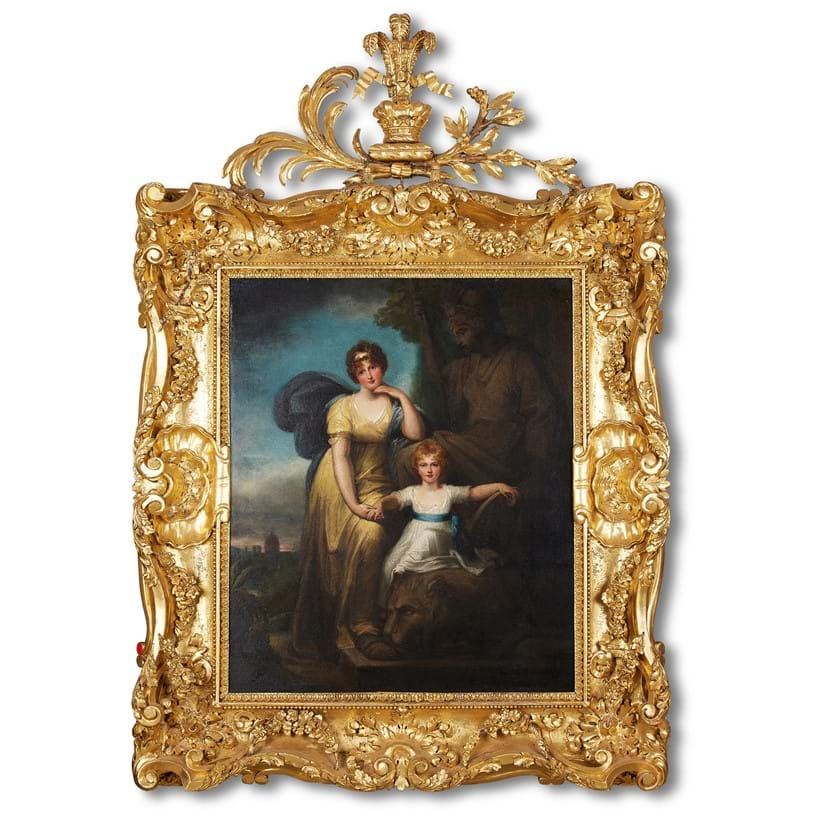
Although the painting is unsigned it is the exemplar for a mezzotint. The choice of Maria Cosway as artist was undoubtedly due to the close friendship that existed between Maria and her husband Richard, a leading portrait painter of the Regency period, with the Prince. In 1785, Richard was appointed Principal Painter to the Prince, and the Prince and the bon ton were frequent visitors at Maria's glittering salons and concerts at Schomberg House, 80-82 Pall Mall, London.
The heads were purportedly later touched and altered by Sir Thomas Lawrence in 1801. That the Princess might ask Sir Thomas Lawrence (1769-1830) to re-touch the faces of this painting because she was unhappy with the original is feasible. Lawrence was the most celebrated portraitist of his age, and patronised by international statesmen and society figures as well as royalty and military leaders. He was a favourite of the Princess, painting her at least three times, including another painting of her and her daughter (1801-2), which survives in the Royal Collection.
This painting came to Weston Hall through the marriage of Lord and Lady Glenbervie's son, Frederick Sylvester North Douglas (1791-1819), politician and classical scholar, to Harriet Wrightson (d. 1864), eldest daughter of William Wrightson of Cusworth, Yorkshire; Harriet inherited Weston Hall through her aunt, Mary Heber, in 1809.
Portrait by Sir Thomas Lawrence (British 1769-1830)
We also have this sensitive portrait of Sylvester Douglas (1743-1823), politician and diarist, and in 1800, Baron Glenbervie of Kincardine, which was painted by Sir Thomas Lawrence in circa 1792, and the same year exhibited at the Royal Academy.
Douglas is shown in a professional capacity as a barrister and King's Counsel; his most recent case brief lies on the table, loosely bound in its traditional red ribbon. The painting portrays him as a man of integrity and intelligence, dedicated to his profession. In its confident and painterly manner, it shows Lawrence to be the natural successor to Gainsborough and Reynolds.
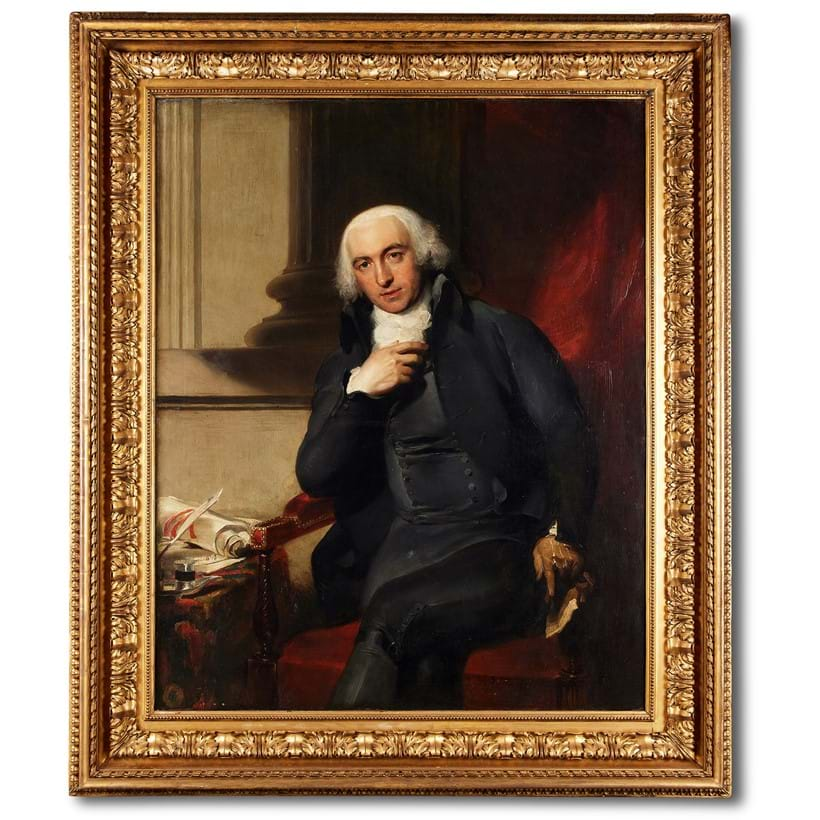
Douglas was born in Fechil, Aberdeenshire, the elder and only surviving son of John Douglas, a landowner of Whiteriggs, Kincardineshire and his first wife, Margaret Gordon, daughter and coheir of James Gordon of Fechil. In 1766, Douglas took a medical degree at Leiden. After further travelling in Europe, to Paris, Italy, Vienna and Hungary, he returned to London in 1769, and switched from medicine to law, entering Lincoln's Inn in 1771. His political ambitions were evident from an early stage for prior to being called to the bar in 1776, he had already published reports on the disputed parliamentary elections to the 1774 House of Commons. From 1778 he reported Lord Mansfield's judicial decisions in King's Bench, published in 1783. He was elected FSA in 1781 and FRS 1795.
Douglas's progression was undoubtedly assisted by his marriage in 1789 to Catherine Anne North (1760-1817), eldest daughter of Frederick North, 2nd Earl of Guilford (1732-92) and Prime Minister from 1770-82. Lord North was renowned for his pacifying approach to the conflict in the colonies, arguing to George III that victory for Britain would be financially disastrous, an important factor in the success of the American War of Independence. Douglas joined the treasury board; in this role he promoted the Irish union, most notably in his speech of 22 April 1799, published in 1800. In January 1800, Douglas was appointed governor to the Cape, and on 30 November the same year he was created Lord Glenbervie of Kincardine in the Irish peerage. In the event he would not take up his position and for the next fifteen years, he was an active member of both the English and Irish parliaments, which he vividly documented in his diaries. These, together with his journals, published piecemeal in 1910 and 1928, are a record of his aspirations and disappointments, interlaced with scandalous anecdotes, political gossip, and travel notes.
After the death of his wife in 1817 and his son in 1819, Lord Glenbervie turned to literary pursuits, publishing his translation of an excerpt from the Italian poet Fortiguerri's Ricciardetto in 1822. He died the following year at Cheltenham on 2 May, 1823, whereupon his title became extinct.
A Decorated Fan by Pavel Tchelitchew (1898-1957
We then have decorated fan, 'Bull fighters' by Russian artist Pavel Tchelitchew. It was gifted by the artist to Dame Edith Sitwell, and as such is signed and dedicated 'To Edith on your birthday'.
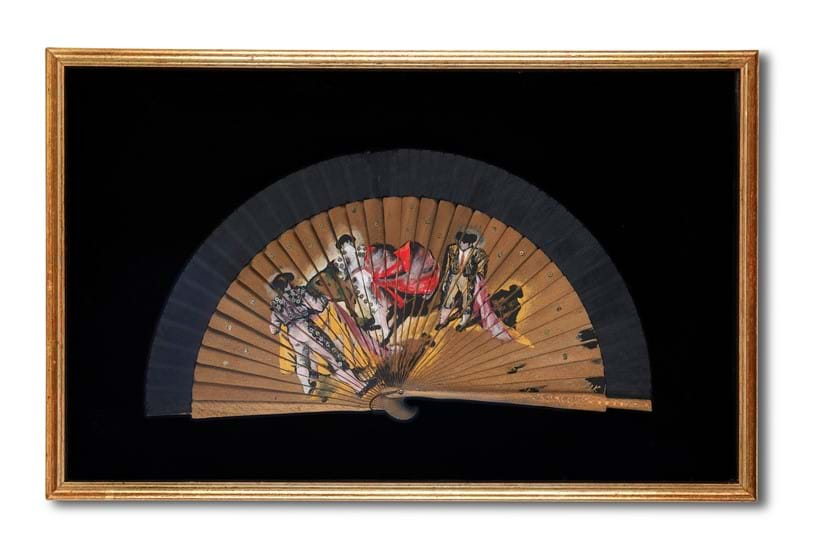
A number of artworks in this sale by the Russian-born surrealist painter, set designer and costume designer, Pavel Tchelitchew (1898-1957), were in the personal collection of Edith Sitwell (1887-1964), poet and literary critic, known for her exotic dress and dramatic lifestyle. Tchelitchew, described as 'the love of her life', was for Edith 'an unhappy platonic romance that dragged on for a quarter of a century' (D. Seward, Renishaw Hall: The Story of the Sitwells, London, 2015, p. 193). Tchelitchew was openly homosexual but despite this, in 1932, Edith moved to the rue Saint-Dominique, Paris, to be close to him, and remained there until 1939 when she was forced to return to Britain at the outbreak of war. Tchelitchew painted six major portraits of Edith during the course of a long and volatile friendship; including a gouache in the National Portrait Gallery, London (NPG 5875), and a gouache at MOMA (173.1978). Some of the drawings and lithographs in this sale were individual gifts by the painter to Edith, with hand-written notes - including lot XX, portrait of Dame Edith Sitwell, seated. However, undoubtedly, Tchelitchew's interest in Edith was purely intellectual, and possibly financial; he describing her as: 'a beautiful sheltered eroticism, the purely passive female sensibility that lives forever, a glass flower under glass, behind the opaque façade so remarkable in itself'. Edith's brother, Osbert (1892-1969), 5th Baronet, was also a great collector of 20th century art - including works by John Piper, Christopher Nevinson, Rex Whistler, and Tchelitchew.
Born to an aristocratic family of landowners, who fled Russia after the Bolshevik Revolution in 1917, Tchelitchew studied under Aleksandra Ekster at the Kiev Academy; his early work was abstract in style described as Constructivist and Futurist, and influenced by Ekster. After graduation, he designed and built theatre sets in Odessa and later Berlin from 1920-1923. In 1923, he went to Paris where he became associated with the Neo-romanticism movement. There, he met the Sitwell family through the American novelist and art collector, Gertrude Stein. His interest in uniting painting, film and dance led to collaborations with the ballet impresario Sergei Diaghilev and choreographer George Balanchine. Tchelitchew is known for his experimentation with new styles, which led to combining multiple perspectives and elements of surrealism and fantasy into his painting. In 1930, he was in New York, exhibiting drawings at the Museum of Modern Art; his most significant work is the painting 'Hide and Seek', painted in 1940-42, and now at MOMA. In 1934, having made a permanent move to New York from Paris with his partner, the poet, Charles Henri Ford, he continued his association with Balanchine, and met his greatest patron, Lincoln Kerstein. In addition to his paintings, Tchelitchew designed sets for Ode (Paris, 1928), L'Errante (Paris, 1933), Nobilissima Visione (London, 1938) and Ondine (Paris, 1939).
An Autograph Manuscript of the 'Valse' from Facade by William Walton
From the family library at Weston Hall, we have an autograph manuscript of the 'Valse' from Facade, dating to circa 1922-1923, by William Walton (1902-1983), together with a loosely inserted black and white photograph of the composer taken in later years.
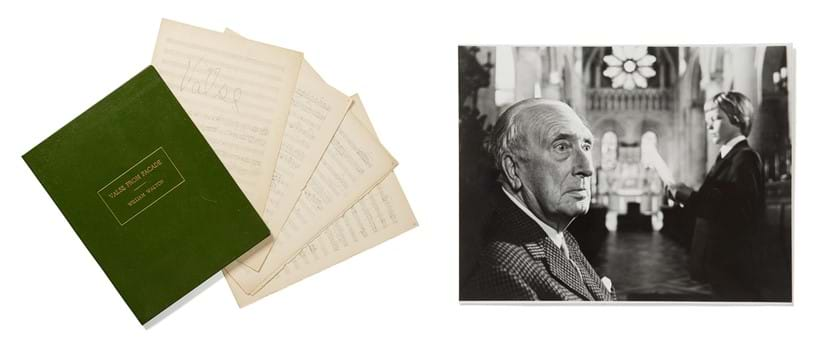
William Walton, a protégé of the Sitwells, wrote the first version of the score aged 20, and composed much of the music for his later choral cantata Belshazzar's Feast whilst he was living at Weston Hall.
Facade is a series of poems by Edith Sitwell, best known as part of 'Facade - An Entertainment', in which the poems are recited over Walton's instrumental accompaniment. The first performance was given at Carlyle Square, 22 January, 1922, before a small private audience of the Sitwell's friends. A disastrous first public performance held at the Acolian Hall, 12 June, 1923, caused and achieved both fame and notoriety for its unconventional form. 'Valse' was included in both the 1931 Frederick Ashton ballet and Orchestral Suite, although Edith did not wish her poems to be part of it.
A Four-Poster Bed and Set of Six Side Chairs Works be Susanna Jennens
Finally, we take a look at this four-poster bed and set of six George III side chairs. The crewel-work embroidery hangings of the four-poster bed, and silk needlework upholstery of the six mahogany chairs offered here were wrought by Susanna Jennens (1688-1760), probably in the 1730s-40s, for her bedchamber at Weston Hall, Northamptonshire.
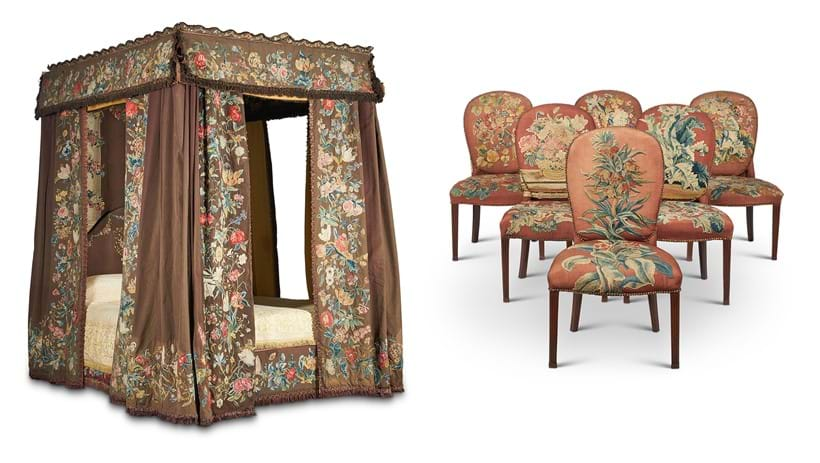
Susanna was the daughter of a distinguished judge, Sir John Blencowe (d. 1726) of Marston St Lawrence and the widow of Richard Jennens of Princethorp in Warwickshire. On 31 August 1714, she leased Weston Hall for seven years for herself and her three young children at a rent of £14 per annum from Thomas Hiccocks, who was on the verge of bankruptcy. The move was evidently successful; in January 1721-22, prior to the expiration of the lease, Susanna's father, Sir John Blencowe, purchased the freehold of Weston for £990 and presented it to his daughter as a Valentine the following month, and in 1731, Susanna described the hall as 'dear Weston' (Sir George Sitwell, A brief history of Weston Hall, Northamptonshire, and of the families that possessed it, London, privately printed 1927, p. 17).
Susanna's bedchamber was on the first floor of Weston Hall. Described as 'a sunny room with two windows overlooking the flower- and fruit-gardens', it was later known as the 'Worked room' as this was where the present bed and hangings and chairs were originally placed, together with window curtains, a tapestry table-top with glass cover, a settee and a carpet, all worked by Susanna (ibid., pp. 12, 24). The decoration of trails and festoons of flowers of the hangings, which includes roses, lilies, hollyhocks, carnations, tulips, jasmine and honeysuckle possibly inspired by those found in the garden at Weston (ibid.).
Crewel-work embroidery, named after the crewel or worsted wool used, was revived in the late 17th century by Queen Mary II (d. 1694), and remained fashionable in the first half of the 18th century (ibid., p. 23). The universal devotion to needlework was such that educated women like Susanna spent many hours at this endeavor. Bed hangings were usually the most important part of the bed, generally referred to as the 'furniture', and were considered more valuable than the wooden bed frames they decorated.
AUCTION DETAILS
Tuesday 16 & Wednesday 17 November | 10.30am BST
Donnington Priory, Newbury, Berkshire RG14 2JE
Learn more
Sign up to email alerts
VIEWING:
Highlights exhibition at Dreweatts London from Tuesday 28 September - Friday 1 October 2021:
16-17 Pall Mall, St James's, London SW1Y 5LU
Full auction on view at Dreweatts Newbury from Wednesday 10 - Monday 15 November 2021:
Donnington Priory, Newbury, Berkshire RG14 2JE
To book an appointment, please email: housesales@dreweatts.com or call 44 (0) 1635 553 553.
ENQUIRIES:
The catalogue will be available and online in October. If you wish to purchase a printed catalogue, the cost including postage is:
UK: £30
Europe: £40
USA / Africa / Asia: £50
Australasia: £55
To pre-order a catalogue, please pay online here. Please put 'SITWELL AUCTION CATALOGUE' in the 'Invoice number' field and ensure you complete all other fields.
General enquiries: + 44 (0) 1635 553 553 | housesales@dreweatts.com
Press enquiries: smaylor@dreweatts.com
















